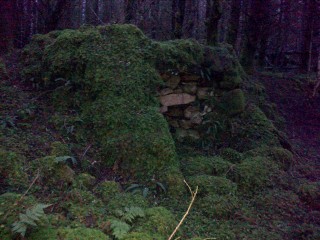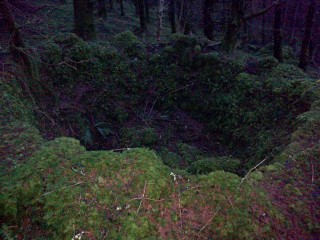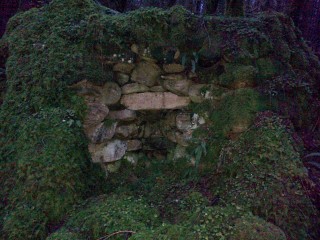Lime Kilns
Lime kilns were once common features of rural landscapes throughout Ireland in the 18th, 19th and 20th centuries. Now, unfortunately, most have been destroyed or have faded into the landscape. Lime kilns were structures in which limestone was heated to a high temperature to produce quicklime. As the pictures show a particularly well preserved example of a lime kiln can be seen on a sloping hillside in a planted forest to the west of Lough Buffy.
The most common type of lime kiln consisted of an egg-cup shaped burning chamber constructed of brick or stone with an air inlet at the base called the ‘eye’. The limestones to be burnt had to be broken into fairly uniform pieces about the size of a man’s fist (by hand or using a hammer) before they were transported to the site by horse and cart or wheel-barrow.
The burning process began with the laying of an iron grate over the eye at the base of the chamber. Then alternating dome-shaped layers of limestone and fuel (wood, furze, coal, turf) were built in the kiln chamber on top of the grate bars. When loading was complete, the kiln was kindled at the bottom and the fire gradually spread upwards through the eye into the chamber burning limestone and fuel in succession. When burnt through, the quicklime was cooled and raked out through the base while the fine ash dropped out and was rejected with the riddling (larger waste materials).
Because the lime kiln was filled from the top, and could also be unloaded from the top, access to the top was necessary. Therefore, kilns were generally constructed on either a rock face or earthen bank to permit this. Ramps were sometimes built to allow access also.
Quicklime or burnt lime as it was also known would have been used primarily on agricultural land to improve the quality of the land by breaking up heavy clay soil, neutralising highly acidic soil or ‘sweetening’ the grass for livestock. Other uses included:
- as a mortar in building
- for white washing house walls to make them waterproof
- as a paint to brighten and disinfect the interiors of house and outhouses
- to prevent foot rot in livestock (often found in heaps at field gates)
- as a medicine
- for removing the hair from hides in leather making
- in cesspits
- slug and snail repellent
- killing ants and other unwanted insects
- as a frost protection for stored potatoes or ‘slits’
- to disinfect walls
- to deter disease on fruit trees
- as a worm drench for pigs
- as rooting powder for cabbage plants
- given to poultry that were producing eggs to strengthen the egg-shells
A tradition relating to lime kilns can be found in Ancient Legends, Mystic Charms and Superstitions of Ireland by Lady Francesca Wilde which says:
“If a ball of worsted is thrown into a lime-kiln and wound up till the end is caught by invisible hands, the person who winds it calls out, “Who holds the ball?” and the answer will be the name of the future husband or wife. But the experiment must be made only at midnight, and in silence and alone.”













Comments about this page
thanks for the helpful insight int these kilns.
Add a comment about this page